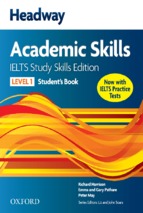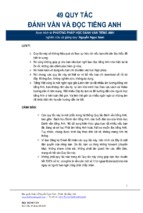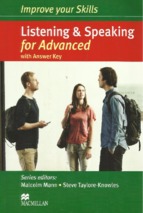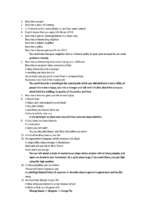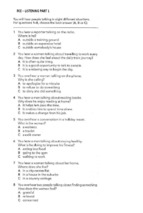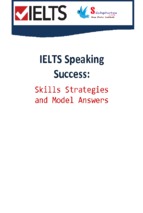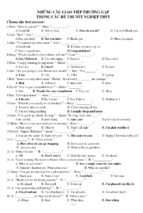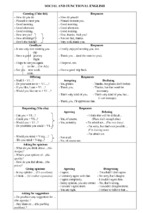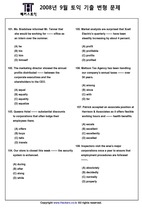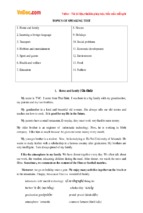Sáng kiến kinh nghiệm giúp học sinh rèn luyện kĩ năng nói trong chương trình học (THCS)
TEACHING EXPERIENCE IDEA: Helping students improve speaking skill at school.
PART I : INTRODUCTION.
Nowadays, English is thought to be one of the most important languages
in the world. There are many reasons why English is so important. One of the
reasons is that English is spoken as the first language in many countries. There
are 104 countries where English is spoken as the first language.
Even in countries where English is not the native language, people use it for
business and tourism. English is used for these purposes in most countries.
English is considered the business language. English is the official language of
the United Nations. English is also the official language of airlines and airports.
However, many Vietnamese students cannot communicate in English, even
though they spent 6-7 years learning English at grammar schools. The problem
is that they learn English just to pass regular tests or examinations, while they
cannot use English in reality. Especially, many students got high scores from
exams and tests, but they can only write grammatical sentences, while they are
very bad at listening and speaking.
The common state
To students, English is not an easy subject and speaking it is much more
difficult. Helping them to improve this skill always makes teacher think.
Having been a teacher for years, I have tried my best to solve this problem for
my students so I have some methods.
PART II : Some methods to solve the state.
Firstly, in each lesson I always encourage students to read texts, dialogues or
answer questions aloud as much as possible so that they have chances to
practice English pronunciation. I also try to give situations from lessons to real
life so as to help students use words, grammars and structures they have learnt
to practice. This makes students have interest in speaking because most of
situations are about their lives or they can use their general knowledge to
express their opinions.
Secondly, students often lack of vocabularies so teacher have to give them
know relative words. Beside that teacher must be sure that students can speak
words correctly. To students at grade six, it is necessary to present a good drill
1
TEACHING EXPERIENCE IDEA: Helping students improve speaking skill at school.
because they must know what they are saying. In this case, I often let students
understand and read the drill fluently then I show them the information such as
pictures, prompts or mime. Sometimes, I create some games to encourage SS to
speak.
Morever, helping students feel confident in speaking is very important so I
usually divide them into suitable groups. For example, in a class I have three
groups: group
one for good student, group two for medium and the last one
for weak students. With
each group, I try to give suitable situations for them to practice speaking.
Finally, I also encourage students to participate in “ English speaking club”.
This is the
useful program for them to have a chance of speaking English. Because many
students
are not good at English so programs for English speaking club are often
designed not
only easy but also interesting so that students feel confident and eager to join.
Part III: Applying in some lessons
Unit 12: Sports and pastimes ( English grade 6)
Lesson 4: B4,5,(6)
B5( How often)
How often does Ly go jogging?
She goes jogging once a week.
After presenting new words and structures for students, I guide them to do the
exercise: “Now, practice with a partner. Ask and answer questions about Ly’s
activities”.
It is easy for medium and good students to look at Ly’s diary (pictures) and
practice speaking. However, to weak students they can’t read name of activities.
To help them to practice, firstly I ask them to write activities on the board.
How often does Ly……….?
She…… …… a week.
2
TEACHING EXPERIENCE IDEA: Helping students improve speaking skill at school.
Activity
Go to school
Play badminton
Listen to music
Go jogging
Play tennis
Read
Watch TV
Go to the movies
Go fishing
How often?
6
2
2
1
1
3
2
2
1
Teacher – student model: Ask a student to stand.
Teacher: How often does Ly go to school?
Student: She goes school six times a week.
After this activity I will call weak students to practice speaking. Others will
check them.
Further practice: How often?
Structure: “How often do you / go / to the movies?
I/ go/ to the movies
I go to the movies (about)
once
two
three times
four time
five times
a weak
a month
a year
Every day
Introduce pictures of the beach, the post office, the city, the theater and the
market or show more pictures of sports and leisure activities. Elicit language
from students.
Teacher:( Show a picture of some one watching TV)
Student 1: How often do you watch TV?
Student 2: I watch TV four times a week.
Teacher 1:( Show a picture of beach)
Student 1: How often do you go to the beach?
Student 2: I go to the beach three times a year.
3
TEACHING EXPERIENCE IDEA: Helping students improve speaking skill at school.
After giving model, I will ask SS to practice in pair and speak aloud. Belong to
the level of students I also give them the chance to ask and answer about their
daily activities without giving prompts or pictures.
Unit 6: Let’s go( English 7)
Lesson 4: B1
Post reading: further practice for suggestions and responses;
Structures - suggestions:
Let’s + V(infinitive)
Why don’t we/ you + V(infinitive)
What about + V-ing
After revise structures of suggestions I ask SS to practice follow pictures and
word given.
Why don’t we…?
4
Let’s……..
TEACHING EXPERIENCE IDEA: Helping students improve speaking skill at school.
What about……?
Why don’t we …?
What about ….?
5
What about…?
Let’s …
TEACHING EXPERIENCE IDEA: Helping students improve speaking skill at school.
When SS remember the way to use : Structures – suggestions, I give them the
responses
Structures - suggestions:
Responses
Let’s + V(infinitive)
Why don’t we/ you + V(infinitive)
What about + V-ing
agree
Good idea
great
Yes,let’s
OK. I’ll come
disagree
Sorry, I can’t
No, I don’t like
* Practice:
b, Make suggestions using the words given:
1. Let’s / go/ swimming
2. Why / join / us ?
3. Let’s / study / library.
4. What / watch / TV ?
(v)
(x)
(v)
(x)
Example: 1. S1 : Let’s go swimming.
S 2 : Good idea !/ Great
After letting students to practice following the guides, I give others pictures
then ask them to practice in pair or in group of three or four.
6
TEACHING EXPERIENCE IDEA: Helping students improve speaking skill at school.
With this activity I can help all SS of the class practice speaking because
pictures are easy for them to name the activities. Besides that, I can give SS a
chance to make a short dialogue of three or four SS belong to the text.
* Chain game:
Unit 10: Staying healthy ( English 6)
.
Aim : S1:What would you like?
S2: I’d like some [fish]
* Further practice:
Procedure:
- Begin the game by saying " I’d like some fish”
- Explain that the first player has to repeat your sentence and then add
something new, ex: I’d like some fish and some vegetables.
- The game continues with each player in turn to remember what the last
player said and then adding something new to the list.
- Players get minus point if they make a memory mistake or hesitate too
long.
- Do not give players minus points for grammar mistake - just correct the
mistake and allow the player to continue.
Ex: Player 1 : I’d like some fish
Player 2 :. I’d like some fish and some vegetables
Player 3 : I’d like some fish, some vegetables and some orange
juice.
Player 4: etc…..
7
TEACHING EXPERIENCE IDEA: Helping students improve speaking skill at school.
This task will help students practice both vocabulary and structure. They also
try to focus on what their fiends say so they can find the mistake to correct. It is
not quite difficult activity. To weak students, I let them to say short sentence
and longer one is for better students.
Aim : Present perfect.( English 8)
Procedure:
- Begin the game by saying " I've done a lot of jobs today. I've washed the
clothes"
- Explain that the first player has to repeat your sentence and then add
something new, ex: I've washed the clothes and hung them.
- The game continues with each player in turn to remember what the last
player said and then adding something new to the list.
- Players get minus point if they make a memory mistake or hesitate too
long.
- Do not give players minus points for grammar mistake - just correct the
mistake and allow the player to continue.
Ex: Player 1 : I've washed the clothes and hung them.
Player 2 : I've washed the clothes, hung them and sweep the floor.
Player 3 : I've washed the clothes, hung them, sweep the floor and
clean the fish tank.
- And so on . Teacher could then begin a new round with a different
situation.
- Ex: He's done a lot of things this week. He's been to the zoo......
- The player with the least number of minus points at the end of the game
is the winner.
UNIT 6: After school.
Lesson 6: B3, (4), (5)
( English 7 )
Aim: Make similar dialogue:
B3:
Nga: It’s my birthday on Sunday. Would you like to come to my house for
lunch?
Lan: Yes, I’d love to. What time?
Nga: At one o’clock.
Lan: I’ll be there.
8
TEACHING EXPERIENCE IDEA: Helping students improve speaking skill at school.
Nga: I’ll see you on Sunday.
Nga: After lunch, We’re going to see a movie. Will you join us?
Lan: I’m not sure. I will call you tomorrow.
Nga : OK.
Lan: Thank for inviting me.
Nga: It’s my pleasure.
- Teacher gives students to listen and practice the dialogue several times.
- Explain the way to make similar dialogue:
+ Teacher asks students to underline the information that will be replaced.
+ Elicit from students to make an outline.
Example:
Event
Date
Place/ activity Time
mother’s birthday
Saturday
buy a gift
with me
brother wedding
sunday
Come to join
Activity after
….
Two o’clock /
Eat hamburger
this afternoon
Prepare flower
six o’clock
and candy .
………
- Teacher gets SS to practice speaking by replaced the information.
- To good students teacher should encourage them to make dialogue
themselves.
Unit 3: At home (English 8)
Lesson 2: Speak
I. Aim: Practicing speaking
II. Objective: By the end of the lesson, Ss will be able to use the prepositions
of place to talk about the positions of furniture in the house
Exercise 1: Look at the picture. Work with a partner. Talk about the position of
each item.
2. Pre - speaking: Revision
+ prepositions of place :
on; in; above; near; next to; beside; opposite; on the left; on the right;
between...and; in the middle; .......
+ Elicit name of items: clock, calendar, refrigerator, dish rack, bowl of fruit,
cooker, knives, sink, towel, pan, sauce pan, stove, lighting fixture , plate, vase
with flower, table, chairs. cupboard.
+ structure: S + is/ are + preposition + O
- Give instruction
- Ask Ss to talk about the position of each item
9
TEACHING EXPERIENCE IDEA: Helping students improve speaking skill at school.
Students will use the words given to describe.
_ Call students to speak aloud.
Ex:
-The plate is on the table
-The calendar is on the wall, under the clock and above the refrigerator.
- The sink is next to the stove.
- The cupboard is on the wall, above the counter.
- The knives are on the wall, under the cupboard.
- The bowl of fruit is between the rice cooker and dish rack.
4. Post- speaking:
Set the scene:
Mrs. Vui bought new furniture for her living room, but she can not decide
where to put it. You should help her to arrange the furniture
- Give the structure:
- Let’s put/I think ( the coffee table) should be... and
-OK. You are right./ No. I think we’ d better/ ought to put….
- Give the model and guide SS to practice.
Ex: - Let’s put the clock on the wall, between the shelf and the picture
- OK I think we ought to put the TV and the stereo on the shelf
- Asks Ss to look at the picture and talk about their ideas.
( Encourage all students to practice. This task should be done by a good student
and a weak / medium student)
- Call some pairs to speak aloud.
Ex:
S1: I think the coffee table should be between the coach and the armchair.
S2: OK. Let’s put the magazines on the shelf above the books.
S3: I think the shelf ought to against the wall.
S4: All right. Let’s put the telephone next to the coach.
S5: The stereo and the TV should be put on the shelf.
S6: Good idea. I think we should hang the picture and the clock on the wall
above the coach.
………………
Unit 8: Country life and city life( English 8)
10
TEACHING EXPERIENCE IDEA: Helping students improve speaking skill at school.
Lesson 2 : Speak+ LF 3,4,5
Aims - By the end of the lesson students will be able to practice speaking about
the changes of a place.
Speak
1. Speak with a partner. Look at the two pictures and talk about the changes
of the town. Then words prompts in the box may help you
- T asks Ps to look at the two pictures on page 73 and talk to their partners
about the changes of the town, using the words in the box under the pictures.
- T writes the words on the board so that they can speak easily.
Picture 1
Small house
Bicycles
Narrow roads
...
Picture 2
High buildings
Motorbikes, cars, taxis
Long and wide roads
...
Structure with get and become ( present progressive to show changes with get
and become)
S + is/am/ are/ + getting/ becoming + adjectives
Ex: The town is becoming busier.
- T gets Ps to work in pairs.
Possible answers:
- The traffic is getting busier.
- There are more tall buildings and houses.
- The houses are getting more modern.
- The town is becoming more beautiful.
- There are more green trees.
- The streets are becoming cleaner / larger / noisier.
- Goods are getting more expensive.
Post speaking:
2. Work with a partner. Talk about changes in your hometown
- T asks Ps to work in groups and talk about changes in their hometown /
neighborhood.
- T calls some Ss to show their ideas before the class, others Ss can add in the
ideas.
Unit 1:A visit from a pen pal ( English 9)
Lesson 2 : Speak + LF2,3
11
TEACHING EXPERIENCE IDEA: Helping students improve speaking skill at school.
Objectives :
By the end of the lesson , students will be able to:
- Introduce themselves, get acquainted with a friend and talk about the city
where they live through words and structures: let me introduce my self;
pleased to meet you.
* Warm up : Introduce oneself
- T. divides class in groups of four
- S1: My name is Tam. I am 15 years old. There are five people in my
family. I like reading and outdoor activities.
- S2: Her name is Tam. She is 15 years old. There are five people in her
family. She likes reading and outdoor activities.
- S3: I am Nam. I am fourteen years old. There are three people in my
family. I like sports such as: volleyball, football.
- S4: He is Nam. He is 14 years old. There are three people in his family.
He likes sports such as: volleyball, football.
* Pre -Speaking :
T. Introduces: Nga is talking to Maryam. They are waiting Lan outside her
school.
-T asks students to do exercise a). The students have to work in pairs to put the
sentences in the correct order to make a complete dialogue.
* Answer :
1–c–5–b–4–d–2–e–3–a–6
Hello. You must be Maryam.
That’s right. I am.
Pleased to meet you. Let me introduce myself. I am Nga.
Pleased to meet you, Nga. Are you one of Lan’s classmates?
Yes, I am. Are you enjoy your stay in Viet Nam?
Oh, yes, very much. Vietnamese people are very friendly and Ha Noi is a
very interesting city.
Do you live in a city, too?
Yes. I live in Kuala Lumpur. Have you been there?
No. is it very different from Hanoi?
The two cities are the same in some ways.
I see. Oh! Here’s Lan. Let’s go.
b) Now you are talking ….
T : Sets the scene : You are talking to Maryam’s friends. Introduce yourself.
T : Asks students to take turns tobe one of Maryam’s friends and practice
speaking.
- First ask some pairs to present their dialogues. Then asks them to practice
with their partners.
12
TEACHING EXPERIENCE IDEA: Helping students improve speaking skill at school.
Now you are talking to Maryam’s friends. Introduce yourself. Make
similar dialogues. Take turns to be one of Maryam’s friends.
- Are you Yoko?
- That’s right. I am.
- Nice to meet you. Let me introduce myself. My name’s Thu. I am 15
years old.
- Me too. Do you live in Vung Tau?
- Yes, I am. Are you from Japan. Which city in Japan do you live in?
- I live in Tokyo- a busy big capital city.
- Do you like Viet Nam?
- Yes. The people are friendly and the beaches are very beautiful.
Unit 2:Clothing ( English 9)
Lesson 2 : Speak
I. Objectives : To ask and respond to questions on personal references.
Warm - up : Word square.
- Stick the poster on the board
A T P L A I N B D F
C R G H T Z L P W Q
P I O I K O Y A M X
L H U E U J R N V L
A S H S W E A T E R
I A E H I N G S J S
D H M O B A G G Y L
T S T R I P E D J O
F I W T J E A N S T
U K B S K I R T B E
* Answers :
sweater, jeans, skirt, striped, baggy, plain.
blouse
plaid, shorts, pants
- Asks students to find 6 nouns and four adjectives about clothing.
- Gets students work in pairs to find words.
- Divides the class into two teams, students from each team go to the board and
circle the words they have found then write them down in the column of their
team. The team which has more words will win the game.
13
TEACHING EXPERIENCE IDEA: Helping students improve speaking skill at school.
a) Match the phrases to the pictures :
- Asks students to do the matching individually, then compare with their
partners to check.
- Calls some students to tell the class about their answers.
- Checks and corrects.
* Check the vocabulary : Kim’s game
- Asks students to remember the phrases in 30 seconds. Then let their books
closed.
- Divides the class into four groups. Students from each group take turn to go to
the board write as many words as they can. Group with the most words wins the
game.
* Answers :
a. a colorful T – shirt
b. a sleeveless sweater
c. a striped shirt
d. a plain suit
e. faded jeans
f. a short – sleeved blouse
g. baggy pants
h. a plaid skirt
i. blue shorts.
b) Interview members of another group.
- Asks students to work in groups 8 or 10 students each to read and write to
more questions for the last section of the survey about students’ wearing.
- Explains and guides students to pay attention to the phrases in exercise a)
before they interview.
- Calls some groups to interview again in front of the class.
* Two more questions :
- What type of clothing do you wear on Tet holiday ?
- What would you wear to a party ?
c) Report the results of the survey :
- Explains the requirement of the task.
- Lets students read the examples in the textbook.
- Asks students to report the results of their survey.
- Calls the leader of each group to present the results of the survey in front of
the class.
* The survey should begin as this :
- Three people said they liked their uniform.
14
TEACHING EXPERIENCE IDEA: Helping students improve speaking skill at school.
- Two people said they usually wore colorful T- shirt on the weekend.
- Lan said she loved baggy pants.
English speaking club
Through several years taking part in ‘English speaking club”, I find that
students at our school are difficult to think about questions for part1- Greeting.
Beside that, in some recently programs, teachers couldn’t be sure that if
students spoke less or more, badly or well when they take turn to ask all their
competitor’s members. In our program this year, I made some changes :
I. Greeting
In this part, two members of each team will ask and answer 5
questions to know partner’s information.
Personal information
name
age
birthday
Address
traffic
grade
class
Friend
job(motherfather)
brothersister
hobbies
Subject
color
Free time
food
weekend
distance
(near/far)
Family
animal
Sports
In this part we had ballots.( team A: 1A, 2A,3A… Team B: 1B,2B,3B…)With
members of two teams we asked them to ballot numbers. So they practiced
speaking in pair: 1A – 1B; 2A-2B,……
Through this cue, students found easier to choose topic that they wanted to
make questions.
Ex:
questions:
1. what’s your name?
2. How old are you?
11.Do you have any brother or sister
12.What does your mother/(father)
do?
3. what’s your date of birth?
13.What’s your hobby? – (I like......)
4. Where do you live?
14.Which sports do you play?
5. How far is it from your house to 15.Which animal do you like best?
school?
15
TEACHING EXPERIENCE IDEA: Helping students improve speaking skill at school.
6. How do you go to school?
7. which grade are you in?
8. which class are you in?
9. Do you have lots of friend
16.What is your favorite color?
17.Which subject do you like best?
18.What’s your favorite food?
19.What do you do in your free
time?
10. How many people are there in your 20.What do you often do at
family?
weekend?
PART IV: CONCLUSION.
Above all are some techniques in teaching English speaking that activities
I have used to teach my students from grade six to nine recent years in the hope
of helping them to improve this skill at school. In fact, it was really much help
me teach new language items, structure as well as grammar. Whenever I started
an interesting activity for speaking, I could see the interest from the students.
In my own opinion, these are good methods to teach English speaking
and practice language skills on lessons at secondary schools.
I tried my best to bring these techniques in speaking lessons, however, my
ability and the facility of chool are still limited. Besides that, students at my
school weren’t good at remembering vocabularies, structures and grammars so
they found it difficult to use old knowledge to speak. They spoke topics or
situations on new lessons much better than speaking general topics.(These
reqired using all the knowledge they learnt). Because of this reason the result of
developing speaking skill last year was not as good as I hoped.
Result in the school year: 2014-2015
Class
number
6A
6B
9A
8B
26
26
27
25
Number of students
who are better at
speaking
18 (69.2%)
16 (61.5%)
19 (70.3%)
14 (56%)
Number of students who
are less better at speaking
8(30.8%)
9 (38.5%)
8 (29.7%)
9 (44 %)
This paper is my great effort, so mistakes are inevitable. I would like to
16
TEACHING EXPERIENCE IDEA: Helping students improve speaking skill at school.
receive your criticism and constructive comments to better it for another time./.
Thank you very much !
Quynh Hoa, March, 22th, 2016.
Thai Thuy Hang
PART V: REFERENCE
1. Techniques in teaching English as a foreign language II
( By: Nguyen Thi Xuan Dao
Hoang Tang Duc)
2. Lesson plans English 6,7,8,9.
3. English books:6,7,8,9
4. Some general knowledge on the internet.
17
TEACHING EXPERIENCE IDEA: Helping students improve speaking skill at school.
18
- Xem thêm -







